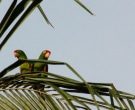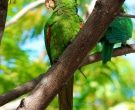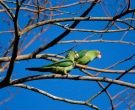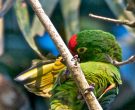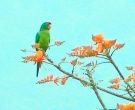Content
|
|---|
Description:
28 cm. of length and a weight of 150 g..
The Crimson-fronted Parakeet (Psittacara finschi) It is the only species of the genus Psittacara tail long with red color below the wing .
They have forecrown and the former area of the lores bright red; the head and the neck green color with the exception of some scattered red feathers. The upperparts and upperwing-coverts green, with some red feathers on the bend of wing. The flight feather green above, more dark towards the tips with a dye bluish light in them vane inner; then golden brown color. Lesser and medium underwing-coverts red, the largest yellow, other coverts pale green. The underparts pale green, sometimes with red at the bottom of the tibia. Upper, the tail grass-green, by down golden brown.
The irises is orange and the eye ring naked is whitish. The bill exhibits a color gray-tipped Horn and the legs off gray color.
It has no sexual dimorphism.
The immature There are very little or almost no red in the forecrown and lack of red color in the thigh or the neck. The lining of the wings is more Orange.
- Sound of the Crimson-fronted Parakeet.
Habitat:
Video – "Crimson-fronted Parakeet" (Psittacara finschi) |
|---|
They inhabit tropical and subtropical envelope 1.400 metres in Costa Rica and 1.600 meters in the West of Panama, in areas with light trees or in fields with scattered trees, in secondary growth forests, edges of the forest, coffee plantations and nearby farmland. Irregular or seasonal in large forested areas.
They are birds gregarious, usually observed in flocks of up to 30 Member, but up to several hundred birds can gather in roosts communal on the tops of the trees or palms. Roosts, at times near the cities.
Reproduction:
They located their nest in holes of various types: natural cavities, old holes of woodpeckers (F. Picidae), stumps of dead Palms. They can dig holes in rotten stumps or in masses of epiphytes.. Sometimes many couples may nest near each other.
The union of the pair of this species is particularly strong. The pairs isolate themselves from the group towards the end of July to nest.. With reproduce during the dry season and the rainy early. The female lays three or four eggs which are incubated during approximately 24 days. The juveniles they leave the nest to the 50 days of life.
Food:
Feeds of corn and sorghum; also eats flowers of the forest flame (Spathodea campalunata), flowers and fruits of poró (Erythrina sp.), guabas (Inga sp.) and fruits of targuá (Croton sp.), lagartillo (Zanthoxylum sp.), guitite (Acnistus arborescens)of guayaba (Psidium guajaba) and higuerón
Distribution:
Widely distributed in the South of Central America, from Nicaragua until Panama.
The species can be found in the southeast of Nicaragua to the South of the Rio Grande, and in Costa Rica mainly on the slope of the Caribbean, Although there are exemplary residents on the side of the peaceful, on Osa Peninsula, at the South-West end and seasonal visitors in the Guanacaste Cordillera, in the North and the central plateau around San Jose.
In Panama they come to the East, a unos 82°W, but it is probable that only seasonally in the lower Highlands of the Province of chiriqui.
Flocks of birds required extensive territories and the species occurs, apparently, in many areas, if only as a post-breeding visitor.
Very common or locally common with increasing numbers in Costa Rica and Panama, probably due to deforestation.
Maintained in captivity and internationally traded in small quantities.
Conservation:
State of conservation ⓘ |
||
|---|---|---|
 Minor Concern ⓘ
(UICN)ⓘ
Minor Concern ⓘ
(UICN)ⓘ
| ||
• Red List category of the UICN current: Least concern
• Population trend: Growing
The size of the world population of the Crimson-fronted Parakeet It has not been quantified, but this species is described as “quite common“.
You can be increasing their geographical range due to deforestation.
abundant on the slope of the Caribbean of Nicaragua. common and widespread in areas deforested over the slope of the Costa Rica Caribbean.
"Crimson-fronted Parakeet" in captivity:
Quite common in United States, less elsewhere.
Socialize easily with human, and can become a committed and loving companion. Es a Intelligent and lively, with easy to imitate the human voice and run different games and exercises. But, We must remember that it is a bird loud and the volume of their calls can get to be very annoying.
Alternative names:
– Crimson-fronted Parakeet, Crimson fronted Parakeet, Crimson-fronted Conure, Finsch’s Conure, Finsch’s Parakeet (English).
– Conure de Finsch, Perriche de Finsch, Perruche de Finsch (French).
– Veraguasittich (German).
– Aratinga-de-finsch (Portuguese).
– Aratinga de Finsch, Perico frentirrojo, Periquito de Pecho Rojo, Perico de Palmera (español).
– Perico frentirrojo (Costa Rica).
– Perico Frentirrojo (Nicaragua).
scientific classification:
– Order: Psittaciformes
– Family: Psittacidae
– Genus: Psittacara
– Scientific name: Psittacara finschi
– Citation: (Salvin, 1871)
– Protonimo: Conurus finschi
Crimson-fronted Parakeet pictures:
Sources:
- Avibase
- Parrots of the World – Forshaw Joseph M
- Parrots A Guide to the Parrots of the World – Tony Juniper & Mike Parr
- Birdlife
-
Photos:
(1) – A Finsch’s Parakeet )also called Finsch’s Conure and Crimson-fronted Parakeet) in San José, Costa Rica By Dominic Sherony [CC BY-SA 2.0], via Wikimedia Commons
(2) – Perico frentirrojo juvenil, approximately 4 months of age, Panama City By Ricaurte (Own work) [Public domain], via Wikimedia Commons
(3) – Crimson-fronted Parakeet, also called Finsch’s Conure By Yazzieyazz (trabjo propioEnglish: own work) [Public domain], via Wikimedia Commons
(4) – Psittacara finschi en el parque nacional Henri Pittier, Venezuela By Roberto Galindo Deshays (Own work) [CC BY-SA 4.0], via Wikimedia Commons
(5) – Crimson-fronted Parakeet Costa Rica 2/15/16 Rancho Naturalistaby Andy Reago & Chrissy McClarren – Flickr
(6) – Crimson-fronted Parakeet by Brian Ralphs – Flickr
(7) – Crimson-fronted Parakeet Costa Rica 2/15/16 Rancho Naturalista by Andy Reago & Chrissy McClarren – Flickr
(8) – Aratinga finschi 06 Apr 2014 Costa Rica, San Lorenzo by Tom Benson – Flickr
(9) – Crimson-fronted parakeet by Charles Sharp – Flickr
(10) – Conurus finschii » = Psittacara finschi (Finsch’s Parakeet) by John Gerrard Keulemans [Public domain], via Wikimedia Commons
- Sounds: Ken Allaire (Xeno-canto)

